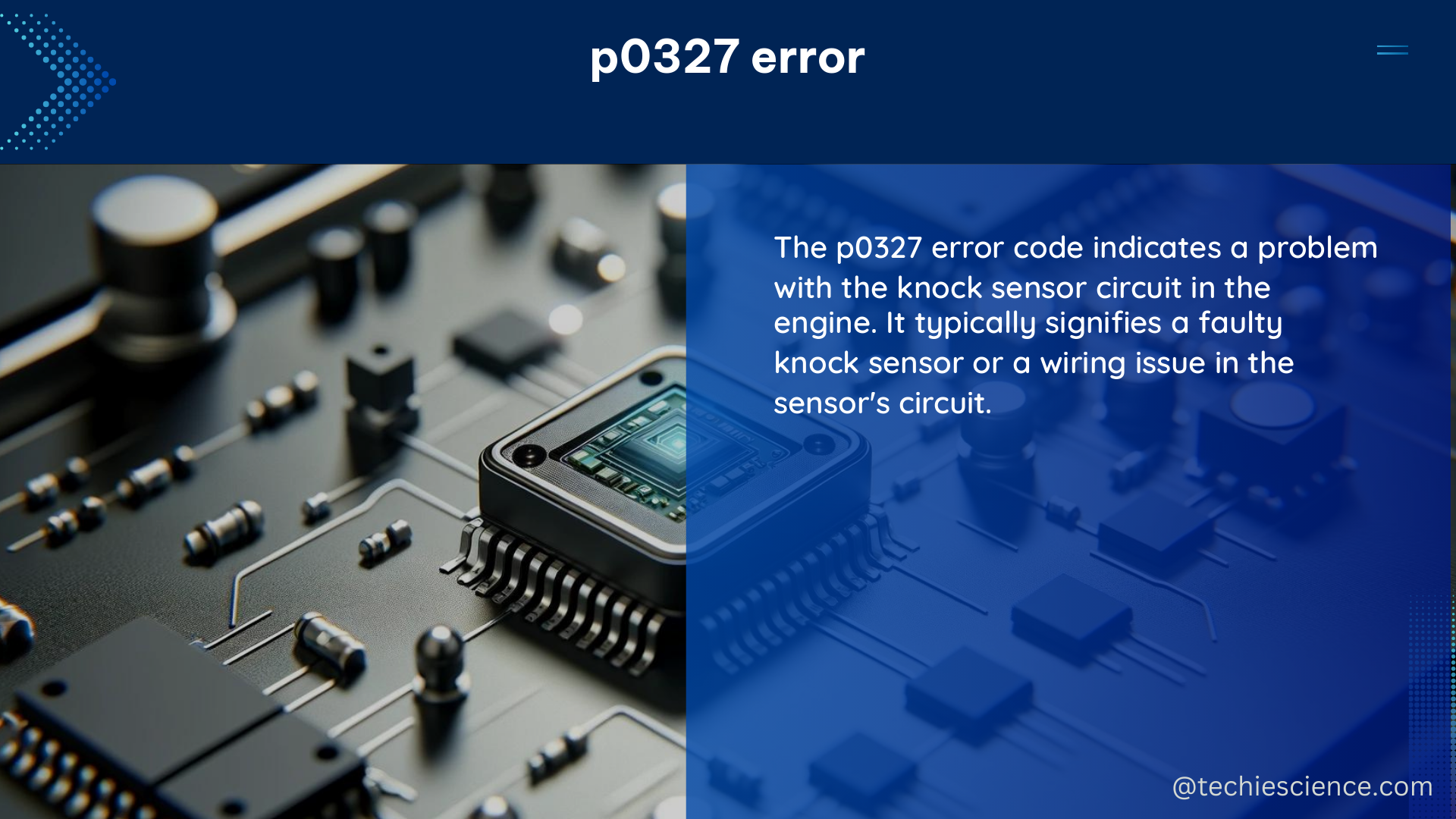Summary
The P0327 error code is a common issue in vehicles, indicating a problem with the knock sensor circuit. The knock sensor detects vibrations from engine knocking or irregular combustion and sends a signal to the engine control computer to adjust the timing. The possible causes of a P0327 code include a bad knock sensor, wiring issues, blown fuses, or engine timing problems.
Understanding the P0327 Error Code

The P0327 error code is specifically related to the knock sensor circuit on the engine’s bank 1. The knock sensor is responsible for detecting any abnormal combustion or engine knocking, which can cause damage to the engine if left unchecked. When the engine control module (ECM) detects a low input signal from the knock sensor, it sets the P0327 code.
Knock Sensor Function
The knock sensor is a piezoelectric device that converts mechanical vibrations into electrical signals. It is typically located on the engine block, near the cylinders. When the engine experiences knocking or pre-ignition, the knock sensor detects the increased vibrations and sends a signal to the ECM. The ECM then adjusts the ignition timing to prevent further knocking and potential engine damage.
Causes of P0327 Error
The most common causes of the P0327 error code include:
- Faulty Knock Sensor: The knock sensor may have failed due to age, physical damage, or exposure to extreme temperatures or vibrations.
- Wiring Issues: The wiring harness connecting the knock sensor to the ECM may be damaged, corroded, or have a loose connection.
- Blown Fuse: A blown fuse in the knock sensor circuit can cause the P0327 code to set.
- Engine Timing Problems: Issues with the engine’s timing, such as a worn timing chain or belt, can cause irregular combustion and trigger the P0327 code.
Diagnosing the P0327 Error
To diagnose and fix the P0327 error, follow these steps:
-
Locate the Knock Sensor: The knock sensor is typically located on the engine block, near the cylinders. Consult your vehicle’s service manual or repair information to identify the exact location of the knock sensor.
-
Inspect the Wiring: Visually inspect the wiring harness connecting the knock sensor to the ECM. Look for any signs of damage, such as frayed, cracked, or corroded wires. Check for loose connections at the sensor and ECM.
-
Test the Knock Sensor: Use a multimeter to test the resistance and voltage output of the knock sensor. Refer to the service manual for the specific test procedures and expected values.
-
Check for Timing Issues: Inspect the engine’s timing components, such as the timing chain or belt, for any signs of wear or damage. Ensure that the timing is properly set according to the manufacturer’s specifications.
-
Perform a Voltage Drop Test: Use a multimeter to check for voltage drops in the knock sensor circuit. This can help identify any issues with the wiring or connections.
-
Clear the Trouble Code: After addressing the underlying issue, clear the P0327 trouble code using an OBD-II scanner or diagnostic tool. Verify that the code does not return.
Fixing the P0327 Error
If the diagnosis reveals a faulty knock sensor, replace it with a new OEM-equivalent part. When replacing the knock sensor, be sure to follow the manufacturer’s installation instructions carefully.
If the wiring or connections are the issue, repair or replace the damaged components as necessary. Check for any loose or corroded connections and ensure that the wiring is properly routed and secured.
In rare cases, the ECM may be the source of the problem. If all other components check out, the ECM may need to be replaced or reprogrammed.
Preventive Maintenance
To prevent the P0327 error from recurring, consider the following preventive maintenance measures:
-
Regular Engine Inspections: Have your vehicle’s engine inspected by a qualified mechanic during routine maintenance intervals. This can help identify any potential issues with the knock sensor or related components before they cause problems.
-
Avoid Pressure Washing the Engine: As demonstrated in the case study, pressure washing the engine can lead to water intrusion and damage to the knock sensor. If necessary, use a gentle stream of water and avoid directing the spray directly at the sensor.
-
Monitor Engine Performance: Pay attention to any changes in engine performance, such as increased knocking or pinging, which may indicate a problem with the knock sensor.
-
Keep Up with Scheduled Maintenance: Adhere to the manufacturer’s recommended maintenance schedule, including replacing the timing chain or belt as specified.
By following these diagnostic and repair steps, as well as implementing preventive maintenance measures, you can effectively address and prevent the P0327 engine knock sensor circuit low input error.
References
- DTC P0327 & P0332 – what is actually tested – how to dial out false … https://forum.hptuners.com/showthread.php
- Knock Sensor P0327/P0332 – issue won’t go away! https://www.silveradosierra.com/threads/knock-sensor-p0327-p0332-issue-wont-go-away.744281/
- How to fix an engine P0327 Code: Knock Sensor 1 Circuit Low Input (Bank 1 or Single Sensor) https://www.youtube.com/watch?v=_fP1TJt_dAM
- P0327 Code. Here we go again. – LS1TECH – Camaro and Firebird https://ls1tech.com/forums/pcm-diagnostics-tuning/44830-p0327-code-here-we-go-again.html
- Error Code P0327 – Knock Sensor – Chevrolet Malibu Forums https://www.chevymalibuforum.com/threads/error-code-p0327-knock-sensor.6816/

The lambdageeks.com Core SME Team is a group of experienced subject matter experts from diverse scientific and technical fields including Physics, Chemistry, Technology,Electronics & Electrical Engineering, Automotive, Mechanical Engineering. Our team collaborates to create high-quality, well-researched articles on a wide range of science and technology topics for the lambdageeks.com website.
All Our Senior SME are having more than 7 Years of experience in the respective fields . They are either Working Industry Professionals or assocaited With different Universities. Refer Our Authors Page to get to know About our Core SMEs.